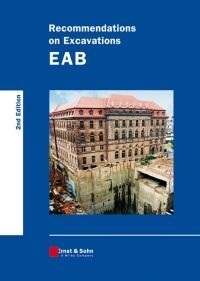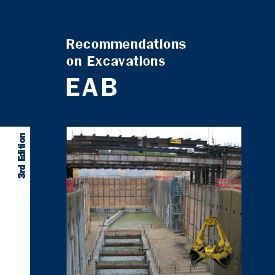Table of contents
GENERAL RECOMMENDATIONS
Civil engineering requirements for applying the Recommendations (R l)
Governing regulations (R 76)
New safety factor approach (R 77)
Limit states (R 78)
Support of retaining walls (R 67)
Using the EAB in conjunction with the Eurocode 7-1 (R 105, draft)
ANALYSIS PRINCIPLES
Actions (R 24)
Determination of soil properties (R 2)
Earth pressure inclination angle (R 89)
Partial safety factors (R 79)
General requirements for adopting live loads (R 3)
Live loads from road and rail traffic (R 55)
Live loads from site traffic and site operations (R 56)
Live loads from excavators and lifting equipment (R 57)
MAGNITUDE AND DISTRIBUTION OF EARTH PRESSURE7
Earth pressure load as a function of the selected construction method (R 8)
Magnitude of active earth pressure without surcharge loads (R 4)
Distribution of active earth pressure load without surcharges (R 5)
Magnitude of active earth pressure from live loads (R 6)
Distribution of active earth pressure from live loads (R 7)
Superimposing earth pressure components with surcharges (R 71)
Determination of at-rest earth pressure (R 18)
Earth pressure in retreating states (R 68)
GENERAL STIPULATIONS FOR ANALYSIS
Stability verification (R 81)
General information on analysis methods (R 11)
Determination and verification of embedment depths (R 80)
Determination of action effects (R 82)
Limit load design method (R 27)
Modulus of subgrade reaction method (R 102)
Finite-element method (R 103)
Verification of the vertical component of the mobilised passive earth pressure (R 9)
Verification of the transmission of vertical forces into the subsurface (R 84)
Stability verifications for braced excavations in special cases (R 10)
Verification of serviceability (R 83)
Allowable simplifications in the STR limit state (R 104, draft)
ANALYSIS APPROACHES FOR SOLDIER PILE WALLS
Determination of load models for soldier pile walls (R 12)
Pressure diagrams for supported soldier pile walls (R 69)
Passive earth pressure for soldier pile walls with free earth supports (R 14)
Toe restraint for soldier pile walls (R 25)
Equilibrium of horizontal forces for soldier pile walls (R 15)
ANALYSIS OF SHEET PILE WALLS AND IN-SITU CONCRETE WALLS
Determination of load models for sheet pile walls and in-situ concrete walls (R 16)
Pressure diagrams for supported sheet pile walls and in-situ concrete walls (R 70)
Soil reactions and passive earth pressure for sheet pile walls and in-situ concrete walls (R 19)
Toe restraint for sheet pile walls and in-situ concrete walls (R 26)
ANCHORED RETAINING WALLS
Magnitude and distribution of earth pressure for anchored retaining walls (R 42)
Verification of force transmission from anchors to the ground (R 43)
Verification of stability at low failure plane (R 44)
Verification of global stability (R 45)
Measures to counteract displacements in anchored retaining walls (R 46)
EXCAVATIONS WITH SPECIAL GROUND PLANS
Excavations with circular plan (R 73)
Excavations with oval plan (R 74)
Excavations with rectangular plan (R 75)
EXCAVATIONS ADJACENT TO STRUCTRUES
Engineering measures for excavations adjacent to structures (R 20)
Analysis of retaining walls with active earth pressure for excavations adjacent to structures (R 21)
Active earth pressure for large distances to structures (R 28)
Active earth pressure for small distances to structures (R 29)
Analysis of retaining walls with increased active earth pressure (R 22)
Analysis of retaining walls with at-rest earth pressure (R 23)
Mutual influence of opposing retaining walls for excavations adjacent to structures (R 30)
EXCAVATIONS IN WATER
General remarks for excavations in water (R 58)
Seepage pressure (R 59)
Dewatered excavations (R 60)
Verification of hydraulic heave safety (R 61)
Verification of buoyancy safety (R 62)
Stability verification of retaining walls in water (R 63)
Dimensioning and construction of excavations in water (R 64)
Water management (R 65)
Monitoring excavations in water (R 66)
EXCAVATIONS IN UNSTABLE ROCK
General Recommendations for excavations in unstable rock (R 38)
Magnitude of rock support pressure (R 39)
Distribution of rock support pressure (R 40)
Bearing capacity of rock for support forces at the wall toe (R 41)
EXCAVATIONS IN SOFT SOILS
Scope of Recommendations R 91 to R 101 (R 90)
Slopes in soft soils (R 91)
Lining systems in soft soils (R 92)
Construction procedure in soft soils (R 93)
Shear strength of soft soils (R 94)
Earth pressure on retaining walls in soft soils (R 95)
Soil reactions for retaining walls in soft soils (R 96)
Water pressure in soft soils (R 97)
Determination of embedment depths and action effects for excavations in soft soils (R 98)
Further stability analyses for excavations in soft soils (R 99)
Water management for excavations in soft soils (R 100)
Serviceability of excavation structures in soft soils (R 101)
VERIFICATION OF THE BEARING CAPACITY OF INDIVIDUAL ELEMENTS
Material parameters and partial safety factors for structural element resistances (R 88)
Dimensioning of soldier pile infill walls (R 47)
Bearing capacity of soldier piles (R 48)
Bearing capacity of sheet piles (R 49)
Bearing capacity of in-situ concrete walls (R 50)
Bearing capacity of waling (R 51)
Bearing capacity of struts (R 52)
Bearing capacity of trench sheeting and bracing (R 53)
Dimensioning of provisional bridges and excavation covers (R 54)
External bearing capacity of soldier piles, sheet pile walls and in-situ concrete walls (R 85)
Bearing capacity of tension piles and grouted anchors (R 86)
MEASUREMENTS AND MONITORIN OF EXCAVATION STRUCTURES
Purpose of measurements and monitoring (R 31)
Preparation, implementation and evaluation of measurements (R 32)
Measured variables (R 33)
Measurement methods and measurements systems (R 34)
Configuration of measurement points (R 35)
Measurement times (R 36)
Transfer and processing of measurement results (R 37)
APPENDIX
BIBLIOGRAPHY
TERMS AND NOTATION
RECOMMENDATIONS IN NUMERICAL ORDER



